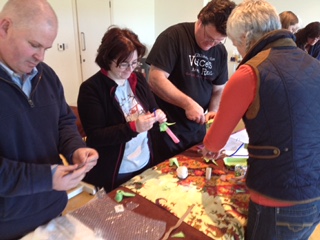Course Details
Amatsu Training is done on a part time basis, one weekend per month. The first two years training take you to Practitioner Level. After the first year you will be a recognised Anma Therapist. On completion of 2 years training you will qualify as an Amatsu Therapist and can set up your own Amatsu clinic.
Our classes run in modular format.
Emphasis in first year (Anma Level) is on the muscles and body movement and in second year (Seitai Level) on bones, ligaments and body movement. Successful completion of examinations and course work (homework and case studies) in each year gives you access to the following year.
There are 8 modules in each year. Each of the modules are run over two consecutive days, and there are 20 full days in the year. Included in the 20 days are a 2 day revision weekend before the exams, and a 2 day exam weekend.
CONTENT OF CLASSES IN ANMA, YEAR 1:
Module 1: Introduction weekend 6-7th September 2025
Module 2: The foot - 11-12th October 2025
Module 3: The knee - 15-16th November 2025
Module 4: The hip - 6-7th December 2025
Module 5: The pelvis - 10-11th January 2026
Module 6: The spine - 14-15th February 2026
Module 7: The shoulder - 14-15th March 2026
Module 8: The neck - 11-12th April 2026
Revision Weekend
A two day revision class will be held 16-17th May 2026.
Exams
We use a mixture of Continuous Assessments throughout the year and then two Practical exams will be held 13-14th June 2026.
Anma means to push and pull, in China this approach was called Amma. Anma works by pushing and pulling on specific areas of the body to release tension and tightness, thereby restoring the normal flows of blood and lymph to promote growth, repair and restoration of normal function. Professor Ling - the founder of modern day Physiotherapy - studied Anma in China prior to establishing his school of Swedish massage and exercise. Therefore Anma is often termed Japanese/Chinese Physiotherapy massage.
Amatsu Anma includes
• Massage techniques
• Stretching, unwinding, neuromuscular techniques
• Positioning, postural ergonomics, alignment methods
• Muscle energy, muscle testing
• Pressure points
Seitai literally means to correct the body and was very popular in Japan until the Meiji period (1868 - 1912). During the 1950's Seitai re-emerged as a natural therapy through the influences of American Chiropractic/Osteopathy and many Seitai colleges in Japan are now known as Seitai Chiropractic Colleges.
Seitai utilises many different methods for body correction, including the following
• Positional re-alignment through postural patterning
• Ligamentous tension balancing
• Soft tissue manipulation
• Deep muscle tension release
• Stress alleviation with body-mind integration.
Seitai focuses on the head (on neck), Hara (spine/pelvis) and the feet to bring about symmetry and paralateral movement.
Therefore, all treatments re-align and re-balance the person from head to toe whilst balancing the meridian circuits of the body and the intrinsic cranial sacral system. This results in a restoration of symmetry and a boost to homeostasis (immune system enhancement) with a reduction of stress and body strain.
Alongside each module there is homework and case studies to be completed in your own time and assessed. Final mark includes exam results plus continuous assessment, which will take into account class attendance, punctuality, performance and effort.
The modules follow the same order as year 1.
Payment Options
Year 1 (Anma)
€300 deposit (payable before 1st August 2025 - this will hold your place)
€3,300 thereafter (payment plans available - see below)
Year 2 (Seitai)
€300 deposit (payable after your exams)
€3,300 thereafter (payment plans available - see below)
We try to facilitate the needs of students when it comes to fee payment and provide a choice of flexible payment methods.
We offer 2 options:
Option 1: Pay €300 deposit before 1st August 2025, balance of €3,300 due in September 2025
Option 2: Pay €300 deposit before 1st August 2025, then 10 monthly payments of €330 from September 2025 to June 2026
In year 2, you must complete 45 case studies. As a qualified Anma practitioner at that stage, you will be able to secure insurance to practice at that level. Therefore, you can charge for your 2nd year treatments which will assist in your fee payment, effectively allowing you to work your way through 2nd year.
What We've Achieved
Since 2012, we have successfully trained and qualified over 80 new Amatsu practitioners. Most have gone on to set up their own clinics, or further develop their existing therapy practices.
We continue to support our students post-graduation. We are always available to provide advice and assistance in both business and clinical matters.
We offer excellent Continued Professional Development with new courses and learning options being developed and running every year.


